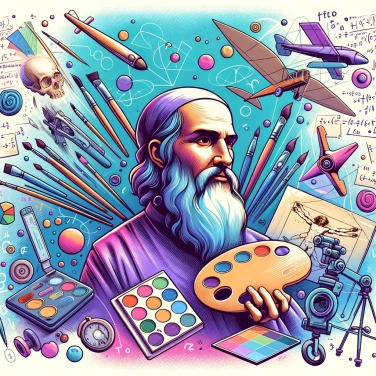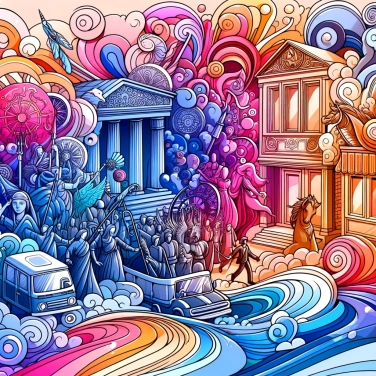Leonardo da Vinci was so gifted in many artistic and scientific fields because of his insatiable curiosity, his meticulous observation of the world around him, and his determination to push the boundaries of knowledge of his time.

Leonard was the type to never settle on just one passion. Interested in everything around him, he wanted to understand how everything worked. Anatomy, mechanics, astronomy, geology, painting... He would effortlessly dive from one subject to another with disconcerting ease. This insatiable curiosity allowed him to ask unprecedented questions and establish improbable connections between seemingly distant fields. Rather than restricting himself to a single discipline, he spontaneously used his diverse knowledge to fuel his thinking and create works or theories that constantly surprised with their originality and depth.
Leonard used an original blend of art and science: in his anatomical drawings, for example, he meticulously observed human bodies through dissection, then represented what he discovered with breathtaking realism. He did not hesitate to conduct experiments to better understand what he was painting—studying light, water, or the movements of the wind to refine his artistic techniques. Conversely, his artistic approaches enriched his scientific studies by providing precision and visual details. He clearly saw that for him, art and science were not opposed but rather complementary and inseparable.
Leonardo had a true gift for capturing details that most people didn't even see. He spent hours studying nature, the movements of water, or the flight of birds, carefully taking notes accompanied by detailed sketches. This meticulous approach fed his scientific understanding, allowing him to realistically reproduce what he observed, particularly through his famous incredibly precise anatomical sketches. His ability to observe closely and analyze his observations in depth also enabled him to anticipate certain modern discoveries, such as his studies of the human body, which were validated several centuries later by contemporary medicine. In short, Leonardo was a true human radar, absorbing every detail to better understand everything around him.
Leonardo was constantly fascinated by the boundary between art and science, and he unapologetically blended these two worlds in his works. He experimented with new techniques like sfumato, allowing for smooth transitions between shadows and light. By methodically observing nature, he understood how to perfectly represent movement, anatomy, and optical effects. On the scientific side, he conducted pragmatic experiments to verify his theories: studies on water, mechanical tests, detailed anatomical sketches made after dissections. Each painting became for him a true testing ground, where art and science worked hand in hand.
Although he is primarily famous for painting, Leonardo da Vinci also drew detailed plans for inventions ahead of their time, such as the armored vehicle, the parachute, and even a precursor model of the helicopter.
Da Vinci was fascinated by human anatomy to the point of personally dissecting more than 30 human corpses to better understand musculature and internal organs, which greatly improved the accuracy of his artistic representations.
Despite his great intellectual productivity, few of his projects were actually completed: many of his works remained unfinished, including several major paintings such as 'The Adoration of the Magi'.
As a true enthusiast of natural sciences, Léonard meticulously studied the flight of birds in an attempt to understand and replicate the mechanisms of human flight.
He primarily used direct and meticulous observation of nature and the human body, making very detailed sketches and notes. He conducted numerous anatomical dissections to study bodily mechanisms and developed innovative drawing techniques such as sfumato to represent his observations with great precision.
His methodical and practical approach has influenced generations of artists and scientists, showing them how to harmoniously combine art, experimentation, and scientific observation. His notebooks, filled with sketches and in-depth notes, continue to inspire researchers and generate universal admiration.
The insatiable curiosity, attentive observation, scientific experimentation, and artistic creativity formed the main foundations of his personal approach. His unique ability to integrate knowledge from various fields greatly contributed to his exceptional versatility.
Leonard is considered ahead of his time due to his visionary ideas and innovative approach that combined rigorous observation with creative imagination. He envisioned machines such as helicopters, parachutes, and hydraulic systems long before their actual practical invention.
Leonardo da Vinci notably distinguished himself in painting, sculpture, anatomy, engineering, mechanical invention, architecture, and natural sciences. His versatility was exceptional for his time, making him an emblematic figure of the Renaissance.

100% of respondents passed this quiz completely!
Question 1/5